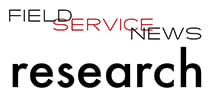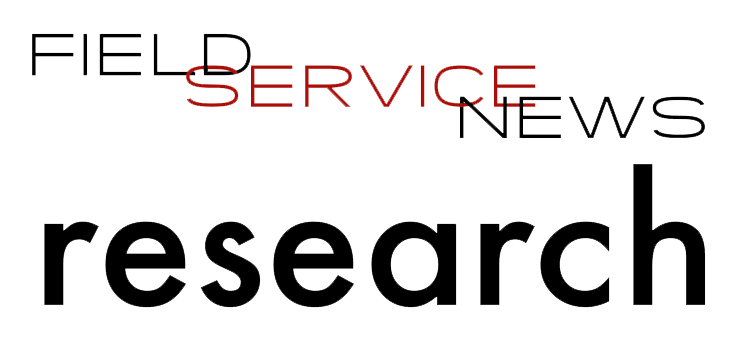Best-Practices in Collecting Customer Feedback
In the previous feature in this series, we looked at the tools used for capturing CSAT (customer satisfaction) data. However, an equally important element within this equation is when such data should be collected...
While in the previous set of questions we saw some apparent trends emerging in that most companies were using standard methodologies to collect their CSAT data (NPS, Customer surveys, Management feedback), there was a much smaller leading-edge group of companies that were using more sophisticated tools (sentiment analysis and social media monitoring).
However, when it comes to when is the best timing is for collecting customer feedback data, there is far less industry consensus.
We asked our respondents to identify when they most frequently collect customer feedback, providing them with four options. These were:
- Engineer collects feedback directly while on visit
- Request sent to the customer within 24 hours of visit
- Request sent to the customer after 24 hours of visit
- We don’t specifically seek customer feedback
Surprisingly almost a fifth of companies (18%) stated that they don’t specifically seek customer feedback. Given the light of the earlier findings of this study, we anticipate that this will be a diminishing number across the coming years.
However, this is still noticeably high.
When identifying the best time to seek customer feedback, the results were fairly evenly split.
The most widely cited response was a request being sent to the customer within 24 hours of the service visit identified by 29% of respondents (figure 4, below). However, the engineer collecting feedback directly from the customer was only narrowly behind this cited by 28% of companies. Finally, a request being sent to the customer after 24 hours was also in a similar ballpark in terms of citations, with 24% of companies stating this is when they most frequently collect customer feedback.

There are, of course, benefits and downsides to each of these approaches, hence why we perhaps see such an even spread within the data.
For example, while direct collection from the engineer is perhaps the most effective means of collecting data, the results are potentially skewed as it may be uncomfortable for the customer to leave negative feedback around the service visit while the engineer is present.
Similarly, a case could be made for requesting feedback within 24 hours, as the service call will be fresh in the customer’s mind. However, should the service prove unsuccessful a few days later, this data will also be inaccurate.
On the flip side, if data is collected more than 24 hours after the service visit, while a more complete picture of the total service experience may be captured the customer may have less recollection of other aspects of the service, such as timeliness of the engineer or other factors.

Indeed, it is a complicated issue to identify a best practice approach regarding timings, as the study findings show – but what about the most effective mechanisms for collecting the data? Here the study does begin to reveal some insights into best practices.
We asked our respondents to rank the effectiveness of each of the following mechanisms for collecting customer feedback data from ‘extremely effective’ through four response options descending to ‘not effective’:
- Engineer request feedback directly in person (direct)
- SMS
- Phone
Of those field service companies that utilised email, direct and phone, most companies scored these measures as ‘very effective’ or ‘extremely effective’.
The highest-ranked of these three mechanisms was phone which 55% of companies ranked as ‘very effective’ or better. Direct collection was ranked by 50% of companies as ‘very effective’ or better, and email was ranked by 49% of companies as ‘very effective’ or better.
When we extend this parameter to include the response ‘reasonably effective’, (figure 5, above) we see direct collection ranked as ‘reasonably effective’ or better by 83% of companies, email ranked by 81% of companies as ‘reasonably effective’ or better, and phone ranked by 78% of companies as ‘reasonably effective’ or better.
The one outlier within this set of responses was SMS.
Only 15% of companies ranked SMS as ‘very effective’ or better, and even when extending this parameter to ‘reasonably effective’ or better, this number remains at less than two fifths (39%) of companies who use this technology to collect customer feedback stating that they believe it is an effective method of data collection.
Given the additional cost of the phone as a mechanism for customer feedback collection compared to both direct and email collection, as well as the issue mentioned above of direct collection potentially being an approach that could potentially skew the data collected, then an argument could be put forward that (as a baseline approach at least) email could be the most cost-effective and reliable means of collecting customer feedback.
 If you are a Field Service News subscriber on either our free-forever FSN Standard subscription tier or our Premium Subscription tier you can access the full 14-page report written by Field Service News, Editor-in-Chief, Kris Oldland that offers in-depth analysis of the research project now on the button below.
If you are a Field Service News subscriber on either our free-forever FSN Standard subscription tier or our Premium Subscription tier you can access the full 14-page report written by Field Service News, Editor-in-Chief, Kris Oldland that offers in-depth analysis of the research project now on the button below.
If you are not yet a subscriber to Field Service News but would like to subscribe and gain access to this report instantly, click the button to visit a dedicated registration page for our complimentary sponsored subscription tier and that will give you instant access to this paper and a number of other assets currently available to subscribers on this tier.
 Data usage note: By accessing this content you consent to the contact details submitted when you registered as a subscriber to fieldservicenews.com to be shared with the listed sponsor of this premium content, HSO who may contact you for legitimate business reasons to discuss the content of this study.
Data usage note: By accessing this content you consent to the contact details submitted when you registered as a subscriber to fieldservicenews.com to be shared with the listed sponsor of this premium content, HSO who may contact you for legitimate business reasons to discuss the content of this study.
Written by Kris Oldland
Kris Oldland has been working in Business to Business Publishing for almost a decade. As a journalist he has covered a diverse range of industries from Fire Juggling through to Terrorism Insurance. Prior to this he was a Quality Services Manager with a globally recognised hospitality brand. An intimate understanding of what is important when it comes to Service and a passion for emerging technology means that in Field Service he has found an industry that excites him everyday.


